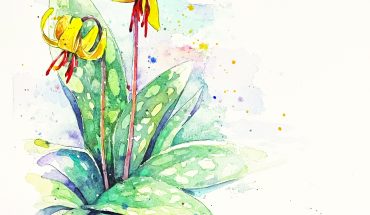by Jim Dodson
Fifteen years ago, a grande dame of English gardening named Mirabel Osler smiled coyly over a goblet of merlot and said something I’ll never forget.
“You know, dear,” she declared, “being a gardener is perhaps the closest thing you’ll ever get to playing God. Please don’t let on to the Almighty, however. He thinks He gets to have all the fun.”
The café in Ludlow, Osler’s Shropshire market town, claimed a Michelin star. But the real star that early spring afternoon in the flowering Midlands of England was Dame Mirabel herself. Spry and witty, the 80-year-old garden designer had reintroduced the classic English “cottage garden” to the mainstream with her winsome 1988 book, A Gentle Plea for Chaos.
The intimate tale of how she and her late husband transformed their working farm into a botanical paradise where nature was free to flourish became a surprise bestseller that fueled a world- wide renaissance in cottage gardening.
It’s actually what inspired me to create my “faux English Southern Garden” on a forest hilltop in Maine.
My visit with Osler was one of several stops I was making across England in
the spring as part of a year-long odyssey through the horticulture world researching a book about human obsession with gardens — including my own.
When I asked Dame Mirabel why making a garden becomes so all-consuming and appealing, she had a ready answer.
“I think among the most valuable things a garden does for the human soul is make us feel connected to the past and therefore each other,” she said, sipping her wine. “We’re all old souls, you know, people who love plants. Especially trees.”
She was delighted that I shared her enchantment with trees, mentioning a gorgeous old American beech that stood beside our house in Maine and how it became the centerpiece of my own wild garden.
When my children were still quite young, we carved our initials into the beech — as one must do with its smooth, gray bark — hoping our names and the tree might reside together forever, or at least a couple hundred years. Unfortunately, our great beech was visibly ailing, which sent me on an odyssey to try to save it. That quest ultimately became a book I wrote called Beautiful Madness.
“I think that’s the alchemy of a beautiful tree,” Dame Mirabel agreed. “They speak to us in a quiet language all their own. They watch over the days of our lives and will long outlive us. No wonder that everyone from Plato to the Druids of Celtic lore believed divinities resided in groves of trees. Trees are living memory-keepers.”
Mirabel Osler passed away in 2016, at age 91. Not long after Beautiful Madness was published in 2006, however, she wrote me a charming note to say how much she enjoyed reading about our visit in Ludlow. True to form, as my wife, Wendy, and I discovered on that unforgettable spring day, Dame Osler’s final garden was a chaotic masterpiece, a backyard filled with beautiful small trees and flowering shrubs arching over a narrow stone pathway.
Not surprisingly, as this long, dark winter of 2021 approached its end, Dame Mirabel was on my mind anew as I began serious work and planning on what will be my fourth — and likely final — garden.
Five years ago, Wendy and I purchased a handsome old bungalow in the neighborhood where I grew up, allowing me to spend the next three years transforming its front and side yards into my version of a miniature enchanted forest — my tribute to Dame Mirabel’s Shropshire garden.
I nicknamed the long-neglected back- yard, dense with overgrown shrubs and half-dead trees, “The Lost Kingdom.” Reclaiming just half of this space was another odyssey, but more than a year later — and thanks to the assistance of a younger back and a Bobcat — a promising shade garden of ferns, hostas, Japanese maples, and a handsome Y0shino Japanese cedar now flourishes there. It reminds me of the many Asian-themed botanical gardens I’ve visited.
That left only a final section of the Lost Kingdom to deal with, which I began clearing late last fall, resulting in a nice blank canvas half in shade, half in sun.
Since Christmas Day, I’ve spent hours just looking at this space the way the author in me stares at a blank white page before starting a new book.
Creating a new garden from scratch is both addictively fun and maddeningly elusive — a tale as old as Genesis. It’s neither for the faint of heart nor skint of wallet.
Gardens, like children, mature and change over time. At best, gardeners and parents must accept that we are, in the end, simply loving caretakers for these living and breathing works of art. Although the Good Lord may have finished His or Her garden in just six days, I fully expect my new final project — which, in truth, is relatively small — to provide years of work and revision before my soul and shovel can rest.
No complaint there, mind you. As the Secretary of the Interior (aka, my wife) can attest, her garden-mad husband enjoys few things more than getting strip-off-before-you-dare-come-into- this-house dirty in the great outdoors, possibly because his people were Orange and Alamance county dirt farmers stretching back to the Articles of Confederation and their verdure seems to travel at will through his bloodstream like runaway wisteria.
After weeks of scheming and dreaming, sketching out elaborate bedding plans and chucking them, it finally came together when a dear old friend from Southern Pines named Max, renowned for his spectacular camellia gardens, gave me five of his original seedlings for the new garden. I planted them on the borders and remembered something Dame Mirabel said about old souls and trees being memory-keepers.
Surrounded by Max’s grandiflora camellias, this garden will be a tribute to the trees and people I associate them with.
A pair of pink flowering dogwoods al- ready anchor a shady corner of the garden where a peony border will pay tribute to the plant-mad woman who taught me to love getting dirty in a garden: my mom.
Nearby will be a pair of flowering crab apple trees like the pair that bloomed every spring in Maine, surrounded by a trio of Japanese maples that I’ve grown from sprouts, linked by a winding path of stone.
A fine little American beech already stands at the heart of this raw new gar- den, a gift from friends that recalls the old tree that sent me around the world. For now, this a good start. There will be more to come. A garden is never really finished, and I’ve only just begun.
Jim Dodson is the New York Times bestselling author of Final Rounds: A Father, A Son, The Golf Journey Of A Lifetime. He lives in Greensboro.
This article originally appeared in the March 2021 issue of WALTER magazine.


